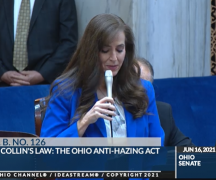BY SUSAN TEBBEN
The recently passed infrastructure bill is set to fund millions of dollars in bridge projects throughout the state, which could include some of the state’s biggest thoroughfares.
U.S. Senator Sherrod Brown said the $100 million in bridge formula funding coming to Ohio through the federal Infrastructure Investment and Jobs Act will bring direct funding as well as competitive grants, allowing everyone from the Ohio Department of Transportation to local county engineers to address maintenance priorities they couldn’t fund in the past.
“This is about making communities safer, making bridges safer,” Brown said in a press call on Wednesday.
So much of the infrastructure in the nation is interconnected, making many thoroughfares throughout the state important not only to Ohio residents, but to companies and services coming from surrounding areas.
Christina Muryn, Republican mayor of Findlay, said the part of I-75 comes through Hancock County rolls goods and services through Ohio, making upkeep important for the local and state economy.
“This is a primary corridor for Findlay and Hancock County where we see industrial growth and planned residential growth,” Muryn said.
It’s those types of projects that are only funded well when they have the input and investment of the community, Muryn said.
“When you go to each community, they can tell you where you’re going to get the best bang for your buck,” Muryn said.
Muryn’s home county, for example, has 372 bridges that are county-maintained, along with 200 center-line miles of road, of which road maintenance crews can only cover about 15 miles a year with the funding as it currently stands.
While Brown said most of the decisions will be made through ODOT, the agency has a list of priorities they’ve curated with the help of local district directors.
Brown said he had particular focus in mind for big bridges in the state, such as the Brent Spence Bridge, traversing the Ohio River between Kentucky and Ohio’s state lines. The bridge, which carries the freight equivalent of 3% of the nation’s gross domestic product according to the National Association of Manufacturers, is in need of improvements and repair after seven decades in existence.
ODOT and the Kentucky Transportation Cabinet have been working together to put together traffic studies and other documentation to decide the best way to use the bridge and an additional bridge to help with increased traffic flow in the area. Brown said he’s confident funding will be secured for that specific project, but that total finances needed to complete the project will be “into the billions of dollars.”
Brown said his office plans to have a meeting in February to help county engineers and other local road crews figure how to apply for funding and which funding would work best for them. That way, projects that are still being visualized and those that are already underway can all receive the funding they need.
“Studies have been done, ground has been broken,” Brown said. “The dirt will start flying around the state of Ohio and jobs will be created pretty quickly.”
***
Also from Ohio Capital Journal:
Brennan Center finds widespread gerrymandering in latest round of redistricting
Ohio’s Supreme Court threw out the state’s latest congressional and legislative maps after determining GOP lawmakers used the process to entrench their partisan advantage. A nationwide study from the Brennan Center for Justice suggests they’re far from alone.
The think tank’s assessment of redistricting now that about half of states have submitted maps shows that, on both sides of the aisle, where partisans control the process, they’re using it insulate their advantages. That could mean a decade-long rightward tilt, the authors argue, because Republicans control the drafting of 187 congressional districts compared to Democrats’ 75. Meanwhile, states with independent commissions have produced maps with far less partisan bias. The authors argue Congress must codify explicit limits on gerrymandering to counteract the trend.
Brennan Center attorneys were part of the legal team representing the parties who successfully challenged Ohio’s latest legislative maps in court. READ MORE
Is meeting all criteria while drawing fair and constitutional maps impossible? Hardly
In order for redistricting maps to pass Ohio Constitution muster, multiple criteria are in play. In addition to federal requirements under the Voting Rights Act, the state constitution as amended by voters in 2015 and 2018 requires state legislative and U.S. congressional district maps be compact, contiguous, competitive, preserve a certain number of whole counties, and proportional to the statewide preferences of voters when it comes to partisan lean.
Specifically, in the congressional plan, the map cannot unduly favor or disfavor a political party or its incumbents, and cannot unduly split governmental units such as townships.
Some Ohio politicians involved in the redistricting process would have us believe that criteria around compactness and not splitting governmental units and counties make it impossible to draw maps that achieve competitiveness and do not unduly favor one political party. They would have us believe it’s impossible to draw constitutional maps closely resembling the 54/46 Republican-to-Democratic split of voter preferences as averaged over the last 10 years in statewide elections.
This is wrong. It’s not impossible. It’s purposefully disingenuous and a flashing red alert of politicians acting in bad faith when they claim that it is.
In fact, according to University of Cincinnati associate professor David Niven, it actually takes a good amount of effort to meet the various other criteria and still draw maps that unduly favor one political party. READ MORE





